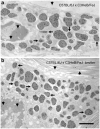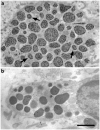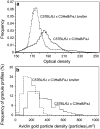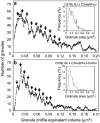Localization of anionic constituents in mast cell granules of brachymorphic (bm/bm) mice by using avidin-conjugated colloidal gold
- PMID: 20127366
- PMCID: PMC3645895
- DOI: 10.1007/s00441-009-0919-2
Localization of anionic constituents in mast cell granules of brachymorphic (bm/bm) mice by using avidin-conjugated colloidal gold
Abstract
We used the egg avidin gold complex as a polycationic probe for the localization of negatively charged sites in the secretory granules of mouse mast cells. We compared the binding of this reagent to mast cell granules in wild-type mice and in congenic brachymorphic mice in which mast cell secretory granules contained undersulfated proteoglycans. We localized anionic sites by post-embedding labeling of thin sections of mouse skin and tongue tissues fixed in Karnovsky's fixative and OsO(4) and embedded in Araldite. Transmission electron microscopy revealed that the mast cell granules of bm/bm mice had a lower optical density than those of wild-type mice (P<0.001) and a lower avidin gold binding density (by approximately 50%, P<0.001). The latter result provided additional evidence that the contents of mast cell granules in bm/bm mice were less highly sulfated than in those of wild-type mice. In both wild-type and bm/bm mast cells, the distribution of granule equivalent volumes was multimodal, but the unit granule volume was approximately 19% lower in bm/bm cells than in wild-type cells (P<0.05). Thus, bm/bm mast cells develop secretory granules that differ from those of wild-type mice in exhibiting a lower optical density and slightly smaller unit granules, however the processes that contribute to granule maturation and granule-granule fusion in mast cells are operative in bm/bm cells.
Figures






Similar articles
-
An histochemical approach to characterization of anionic constituents in mast cell secretory granules.Histochem Cell Biol. 1995 Dec;104(6):453-8. doi: 10.1007/BF01464335. Histochem Cell Biol. 1995. PMID: 8777731
-
Changes in the distribution of anionic constituents in secretory granules of mouse pancreatic acinar cells after pilocarpine-induced degranulation.J Histochem Cytochem. 2001 Oct;49(10):1199-204. doi: 10.1177/002215540104901001. J Histochem Cytochem. 2001. PMID: 11561003
-
Distorted secretory granule composition in mast cells with multiple protease deficiency.J Immunol. 2013 Oct 1;191(7):3931-8. doi: 10.4049/jimmunol.1301441. Epub 2013 Aug 23. J Immunol. 2013. PMID: 23975861
-
Mast cell proteoglycans.J Histochem Cytochem. 2012 Dec;60(12):950-62. doi: 10.1369/0022155412458927. Epub 2012 Aug 16. J Histochem Cytochem. 2012. PMID: 22899859 Free PMC article. Review.
-
Regulation of secretory granule size by the precise generation and fusion of unit granules.J Cell Mol Med. 2010 Jul;14(7):1904-16. doi: 10.1111/j.1582-4934.2010.01071.x. Epub 2010 Apr 19. J Cell Mol Med. 2010. PMID: 20406331 Free PMC article. Review.
References
-
- Bayer EA, Wilchek M. Modified avidins for application in avidin-biotin technology: an improvement on nature. In: Sim JS, Nakai S, editors. Egg uses and processing technologies. CAB International; Wallingford: 1994. pp. 158–176.
-
- Bergstresser PR, Tigelaar RE, Tharp MD. Conjugated avidin identifies cutaneous rodent and human mast cells. J Invest Dermatol. 1984;83:214–218. - PubMed
-
- Bussolati G, Gugliotta P. Nonspecific staining of mast cells by avidin-biotin-peroxidase complexes (ABC) J Histochem Cytochem. 1983;31:1419–1421. - PubMed
-
- Chi EY, Lagunoff D. Abnormal mast cell granules in the beige (Chédiak-Higashi syndrome) mouse. J Histochem Cytochem. 1975;23:117–122. - PubMed
-
- Collins TJ. ImageJ for microscopy. Biotechniques. 2007;43(Suppl):25–30. - PubMed
Publication types
MeSH terms
Substances
Grants and funding
LinkOut - more resources
Full Text Sources

